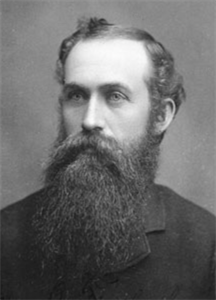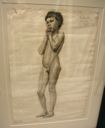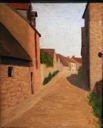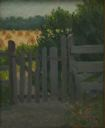John B Fairbanks
painting
(Payson, Utah, 1855 - 1944, Salt Lake City, Utah)
John B. Fairbanks was born in Payson, Utah, on December 27, 1855. His parents, John Boylston Fairbanks and Sarah Van Wagoner Fairbanks, crossed the plains with a Mormon wagon train in September of 1847. Because he and his father shared the same name, he was referred to as J. B. by his family. As a young boy, J. B.'s interest in art was apparent. His mother owned two pictures she prized a great deal. One was a steel engraving of Rosa Bonheur's Horse Fair and the other was a print of an old family home in Massachusetts. J. B.'s mother had the pictures stored safely in a trunk to preserve them. J. B. was so interested in the pictures that he took every opportunity to examine them. He handled them so often they began to show signs of wear. His mother finally decided to hang the pictures in their home so J. B. could view them as much as he wanted without touching them. Though he always loved art, it was not until J. B. was 18 years old that an experience moved him to choose art as his profession. John Hafen, the well-known artist, moved to Payson and opened a studio. At the time, J. B. was preoccupied by baseball; however, one day he visited John Hafen's studio and after seeing his works, he forgot baseball, and he focused his ambition on art. He spent a great deal of time at Hafen's studio watching the artist, until one day, Hafen asked him to paint a picture. J. B. painted a picture of an old Welsh castle that was so well executed, he had difficulty convincing his mother it was his own work. When he finally did convince her it was his work, she was so pleased that, with tears in her eyes, she hugged him and cried: "John, you are an artist." John Hafen became J. B.'s mentor and friend and remained so for the rest of his life. J. B. worked for several years, often in conjunction with Hafen, painting landscapes of Utah and drawing portraits of such notable state figures as George Q. Cannon and Heber J. Grant. Although he received praise for a number of his works, artistic success eluded him, and he worked at various jobs including enlarging photographs for George Edward Anderson and selling newspapers. Fairbanks married Lilly Annetta Huish on June 24, 1877. He also served a mission for the Mormon church to the Southern States Mission in 1881-1883. One of the most important events in Utah art history occurred in 1890, when John Hafen and Lorus Pratt visited George Q. Cannon of the First Presidency of the LDS church to request funding to study art in France. The artists had been called to paint murals in the soon-to-be-completed Salt Lake Temple and wished to receive better training before beginning. The funding was granted and three artists were chosen to travel to France: John Hafen, Lorus Pratt, and J. B. Fairbanks. The three were given $1,800 and were set apart by the church as "missionaries with a special purpose." The three artists enrolled in the Academie Julian in 1890, where they studied figure drawing in the studio and landscape painting in the French countryside. The approach of painting outdoors was new to the three Utah artists, but all enthusiastically embraced it. J. B. studied with several artists including Rigelot, who painted in the French Rural Naturalist style using muted colors and tone. Fairbanks also trained under Benjamin Constant, who was so pleased with J. B.'s improvement while in France, he suggested J. B. needed no further instruction in landscape painting. While in Paris, J. B. painted a copy of the Horse Fair by Rosa Bonheur that had so much influence on him as a child. Then, with their studies completed, the three artists returned to Utah to direct the painting of the murals in the Salt Lake LDS temple. After the murals in the Salt Lake temple were completed, Fairbanks traveled to Arizona to assist with the murals in the Mesa temple. After the painting in the temples was completed, J.B. struggled for a time as an artist. He was a Tonal Impressionist who, more than any other Utah Paris-trained artist, felt the necessity of painting "The Farm." In spite of the relevance of his work to early Utah life, his exhibited paintings often were ignored or only faintly praised. In addition to his limited artistic success, in 1898, his wife Lilly fell down the stairs while carrying their youngest son Avard. She died, leaving J. B. with seven children to care for. In 1900, he left his oldest son Leo and his daughter Nettie to care for the younger children while he traveled to South America. The Cluff Archeological Expedition had hired him to sketch and photograph the travels of the group. During his two years in South America, he found time to make numerous sketches from which he later produced beautiful paintings. After his return, J. B. married Florence Gifford, and she bore him five more children. Several of J. B.'s children followed their father into the art profession. Leo and Avard were the most successful and spent a great deal of money and effort in supporting their brothers and sisters when their father was gone or was not able to support them. Although J. B. continued to paint and sell pictures, he was from time to time, forced to take a position as a window dresser to get by. Fairbanks also became an art educator, serving as art supervisor in Ogden, he replaced John Hafen, teaching at the LDS College in Salt Lake City, and as a board member of the Utah Art Institute. J. B. continued to paint for the remainder of his life; finally, in the 20th Century he received some positive recognition, but never the success and fame he had obtained during his trip to France. After a life dedicated to art, J. B. Fairbanks passed away at the age of 85 in 1940.
painting
(Payson, Utah, 1855 - 1944, Salt Lake City, Utah)
John B. Fairbanks was born in Payson, Utah, on December 27, 1855. His parents, John Boylston Fairbanks and Sarah Van Wagoner Fairbanks, crossed the plains with a Mormon wagon train in September of 1847. Because he and his father shared the same name, he was referred to as J. B. by his family. As a young boy, J. B.'s interest in art was apparent. His mother owned two pictures she prized a great deal. One was a steel engraving of Rosa Bonheur's Horse Fair and the other was a print of an old family home in Massachusetts. J. B.'s mother had the pictures stored safely in a trunk to preserve them. J. B. was so interested in the pictures that he took every opportunity to examine them. He handled them so often they began to show signs of wear. His mother finally decided to hang the pictures in their home so J. B. could view them as much as he wanted without touching them. Though he always loved art, it was not until J. B. was 18 years old that an experience moved him to choose art as his profession. John Hafen, the well-known artist, moved to Payson and opened a studio. At the time, J. B. was preoccupied by baseball; however, one day he visited John Hafen's studio and after seeing his works, he forgot baseball, and he focused his ambition on art. He spent a great deal of time at Hafen's studio watching the artist, until one day, Hafen asked him to paint a picture. J. B. painted a picture of an old Welsh castle that was so well executed, he had difficulty convincing his mother it was his own work. When he finally did convince her it was his work, she was so pleased that, with tears in her eyes, she hugged him and cried: "John, you are an artist." John Hafen became J. B.'s mentor and friend and remained so for the rest of his life. J. B. worked for several years, often in conjunction with Hafen, painting landscapes of Utah and drawing portraits of such notable state figures as George Q. Cannon and Heber J. Grant. Although he received praise for a number of his works, artistic success eluded him, and he worked at various jobs including enlarging photographs for George Edward Anderson and selling newspapers. Fairbanks married Lilly Annetta Huish on June 24, 1877. He also served a mission for the Mormon church to the Southern States Mission in 1881-1883. One of the most important events in Utah art history occurred in 1890, when John Hafen and Lorus Pratt visited George Q. Cannon of the First Presidency of the LDS church to request funding to study art in France. The artists had been called to paint murals in the soon-to-be-completed Salt Lake Temple and wished to receive better training before beginning. The funding was granted and three artists were chosen to travel to France: John Hafen, Lorus Pratt, and J. B. Fairbanks. The three were given $1,800 and were set apart by the church as "missionaries with a special purpose." The three artists enrolled in the Academie Julian in 1890, where they studied figure drawing in the studio and landscape painting in the French countryside. The approach of painting outdoors was new to the three Utah artists, but all enthusiastically embraced it. J. B. studied with several artists including Rigelot, who painted in the French Rural Naturalist style using muted colors and tone. Fairbanks also trained under Benjamin Constant, who was so pleased with J. B.'s improvement while in France, he suggested J. B. needed no further instruction in landscape painting. While in Paris, J. B. painted a copy of the Horse Fair by Rosa Bonheur that had so much influence on him as a child. Then, with their studies completed, the three artists returned to Utah to direct the painting of the murals in the Salt Lake LDS temple. After the murals in the Salt Lake temple were completed, Fairbanks traveled to Arizona to assist with the murals in the Mesa temple. After the painting in the temples was completed, J.B. struggled for a time as an artist. He was a Tonal Impressionist who, more than any other Utah Paris-trained artist, felt the necessity of painting "The Farm." In spite of the relevance of his work to early Utah life, his exhibited paintings often were ignored or only faintly praised. In addition to his limited artistic success, in 1898, his wife Lilly fell down the stairs while carrying their youngest son Avard. She died, leaving J. B. with seven children to care for. In 1900, he left his oldest son Leo and his daughter Nettie to care for the younger children while he traveled to South America. The Cluff Archeological Expedition had hired him to sketch and photograph the travels of the group. During his two years in South America, he found time to make numerous sketches from which he later produced beautiful paintings. After his return, J. B. married Florence Gifford, and she bore him five more children. Several of J. B.'s children followed their father into the art profession. Leo and Avard were the most successful and spent a great deal of money and effort in supporting their brothers and sisters when their father was gone or was not able to support them. Although J. B. continued to paint and sell pictures, he was from time to time, forced to take a position as a window dresser to get by. Fairbanks also became an art educator, serving as art supervisor in Ogden, he replaced John Hafen, teaching at the LDS College in Salt Lake City, and as a board member of the Utah Art Institute. J. B. continued to paint for the remainder of his life; finally, in the 20th Century he received some positive recognition, but never the success and fame he had obtained during his trip to France. After a life dedicated to art, J. B. Fairbanks passed away at the age of 85 in 1940.
Artist Objects






















